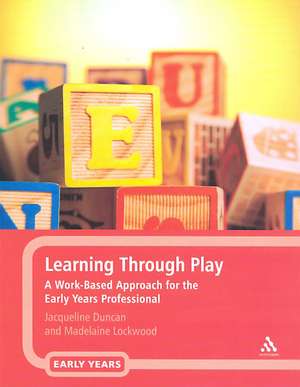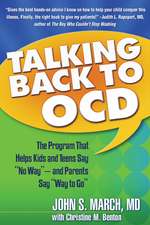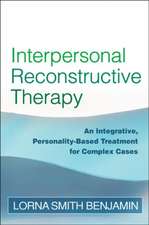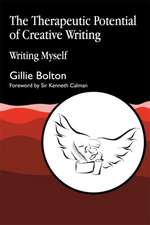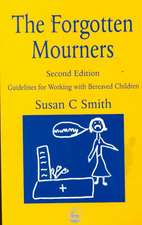Learning Through Play: A Work-Based Approach for the Early Years Professional
Autor Jacqueline Duncan, Madelaine Lockwooden Limba Engleză Paperback – 14 mar 2008
Preț: 308.45 lei
Nou
Puncte Express: 463
Preț estimativ în valută:
59.03€ • 61.25$ • 49.34£
59.03€ • 61.25$ • 49.34£
Carte tipărită la comandă
Livrare economică 15-29 martie
Preluare comenzi: 021 569.72.76
Specificații
ISBN-13: 9781847061683
ISBN-10: 1847061680
Pagini: 264
Ilustrații: Illustrations
Dimensiuni: 189 x 246 x 20 mm
Greutate: 0.53 kg
Editura: Bloomsbury Publishing
Colecția Continuum
Locul publicării:London, United Kingdom
ISBN-10: 1847061680
Pagini: 264
Ilustrații: Illustrations
Dimensiuni: 189 x 246 x 20 mm
Greutate: 0.53 kg
Editura: Bloomsbury Publishing
Colecția Continuum
Locul publicării:London, United Kingdom
Caracteristici
Learning Through Play offers many key features that include professional development activities, resources for further study and numerous frameworks for best practice within early years settings.
Cuprins
Part 1: How Children Learn1. The Role of the Adult: Making Observations and Understanding the ChildThe role of the practitioner as observer in understanding children's playWhat is observation?Why observe children play?A framework for effective observationEthics2. The Child as a Thinker and LearnerThe brain and learningChildren constructing their own understandingThe role of representation, language and interaction in learningLearning starts from where the child isScaffoldingThe spiral curriculumMultiple intelligencesLearning dispositions and child involvementActive learning schema3. Aspects of Development: Influences on LearningThe influence of social and cultural contexts in which the child is developingThe influences on development: relationships, stimulation, health, gender, environment and playHow development affects learning and dispositions to learningPlay and its influences on learning4. Key Ideas That Inform Us About Learning Through Play Young children are competent and experienced learners Children's learning is influenced by significant othersLanguage is a central mechanism in learningChildren's own talk has a crucial function in their learning Learning can be scaffoldedObservation can help us understand and support children's thinkingLearning and development in one area can affect learning in all othersChildren learn best when actively involved in learningPart 2: Play and its Role in Pre-School Education5. Play and LearningWhat do we mean by play? Play in the educational contextHow does good quality play support learning?But what do we mean by good quality play?Key aspects of playTypes of play and their importance6. Developing the Context: Making Sense of Your SettingEvaluation of key principles The role of the practitioners in playPersonal development Part 3: Key Principles for Developing and Supporting Play7. The Role of the Practitioner: Monitoring and Assessment of Children's Learning Through Play Defining monitoring and assessmentReasons for monitoring and assessingKey principles for monitoring and assessing children's learning through playApproaches and procedures for monitoring and assessmentExemplar for assessment and recording8. The Learning Environment: Provision and Resources Why is the physical learning environment important? What makes a quality play environment?Planning provision areas9. The Role of the Adult in Supporting Sustained Meaningful Play: Intervention What do we mean by intervention?Why intervene?What intervention strategies do settings adopt?How can we intervene successfully?What approaches might we adopt?When might we choose not to intervene? 10. Planning: Developing a Framework for Children's Learning Through Play Defining planning for playReasons for planning playThe planning for play continuumKey principles for planning for play The planning for play process Part 4: Management, Evaluation and Development of Quality Pre-School Provision11. The Role of the Adult: Leadership and Management The role of the practitioner in leading and managing learning through play Key principles and frameworks for the effective management and leadership of learning through playThe development of adult relationshipsThe importance of teamwork in providing high quality playThe characteristics involved in developing strong teamworkManage the observation, assessment, planning and intervention cycle12. Developing Your Context: Where Do We Go from Here?The improvement cycle: a framework for improving play in your settingEnvisioning the play provision for your contextCompleting an auditWriting a policy for playDevelopment planning Action planning EvaluationPersonal learning and development
Recenzii
Book description in Nursery World
"...guides readers on how to develop the early-childhood curriculum and pedagogy though play-based learning. It places emphasis on practical application and provides guidance on the management of play-based learning in early years setting." asiaone.com, December 2009
"...guides readers on how to develop the early-childhood curriculum and pedagogy though play-based learning. It places emphasis on practical application and provides guidance on the management of play-based learning in early years setting." asiaone.com, December 2009
